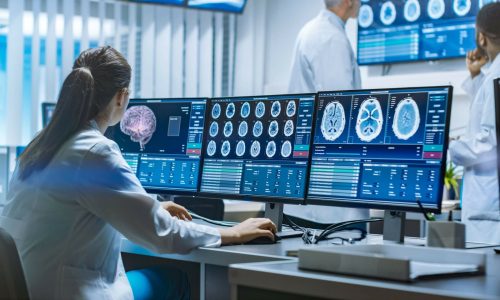Why is Medical Annotation Important?

AI in healthcare depends heavily on high-quality annotated data to:
- Detect abnormalities such as tumors, fractures, or infections.
- Classify diseases and assess severity in diagnostic imaging.
- Segment organs, tissues, or lesions for treatment planning.
- Analyze pathology slides for cancer detection or cellular analysis.
- Interpret clinical text for automated reporting and documentation.
Accurate annotation improves model reliability, patient safety, and clinical efficiency. Without well-annotated datasets, AI cannot generalize across varied medical cases, potentially leading to diagnostic errors.
Types of Medical Annotation
Image Annotation
Involves marking regions of interest (ROIs) in medical scans—like lungs, heart, tumors, or fractures—using bounding boxes, polygons, or semantic segmentation. For instance, in chest X-rays, segmentation can highlight pneumonia regions; in MRIs, it can map tumor boundaries. This annotation trains AI to recognize visual patterns that indicate specific diseases.


Text Annotation
Applied to medical records, doctor’s notes, and reports to identify entities such as symptoms, diagnoses, medications, or procedures. Named Entity Recognition (NER) and relation extraction help AI understand clinical relationships—for example, linking a symptom to a condition. This is essential for building medical chatbots, electronic health record (EHR) analysis tools, and research databases.
Audio Annotation
Used to transcribe and label medical dictations, patient-doctor conversations, or telehealth consultations. Speaker diarization, intent labeling, and emotion tagging help AI systems understand context, tone, and medical terminology, improving automated transcription accuracy and virtual assistant functionality.


Video Annotation
In surgical or procedural videos, annotation tracks instruments, movements, and anatomical regions. This enables AI to learn surgical workflows, assist in robotic surgery, and identify complications in real time. Temporal labeling marks key moments, such as incision, suture, or anomaly detection.
Our medical Annotation use cases:
Clinical: Annotating patient records for faster diagnosis and treatment insights.
Radiology: Labeling X-rays, CTs, and MRIs for accurate abnormality detection.
Dentistry: Marking dental images to identify cavities and alignment issues.
Cardiology: Annotating ECGs and heart scans for early detection of conditions.
Ophthalmology: Tagging eye images to detect glaucoma and other disorders.
Pathology: Labeling tissue slides to identify cancerous or abnormal cells.
Dermatology: Annotating skin images to classify conditions like acne or melanoma.
And more: Supporting AI across multiple healthcare domains for better outcomes.


